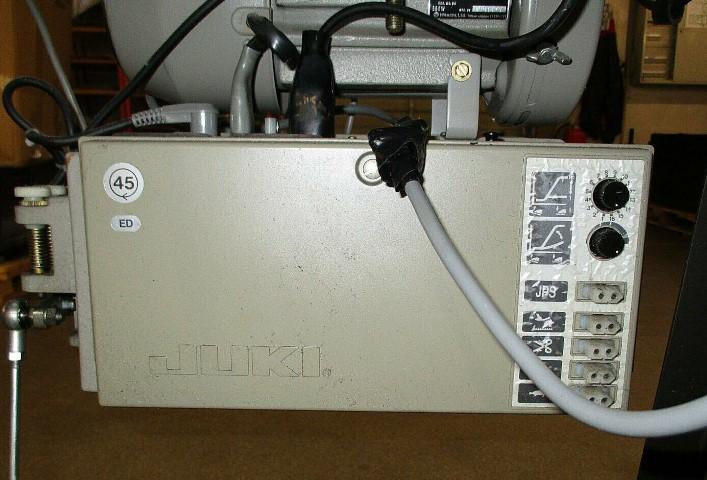-
Posts
5,759 -
Joined
-
Last visited
Content Type
Profiles
Forums
Events
Blogs
Gallery
Everything posted by Constabulary
-
I don't know the difference either. Beside what dikman said the SV model sometimes is a standard model with just different accessories. The 110 is a machine with very short stitch length. Usually they have 3 preset stitch length that change by shifting gears on the left side of the machines. So a different (maybe longer than standard) stitch length could be but who knows. Keep us updated with your projects.
-
Looks like they are the same machines so question is how well is the machine setup with motor and how well it is adjusted by the dealer (sewn off and so forth) To be honest no matter what machine with what motor you buy I would always add a speed reducer. That is so much more comfortable. Some motor may start super slow but often do not have much low speed torque. The speed reducer compensates this and the advantage of a speed reducer should not be underestimate IMO (adding torque & reducing sewing speed). I have one on ALL my machine tables. ALL - no matter the motor and no matter the machine - it´s just a lot more comfortable. My 2 cents.
-
Some like it some don´t like it because it often looks just ugly (IMO) but thats a personal opinion. I would always go the speed redcuer way as long as I do not find a proper looking fly wheel with a grip on the rim (not just a pulley). It´s not the technical aspect, it´s the optical aspect. But thats just me. I built my cheap DIY speed reducers for less than 25€ I think.
-
DOT Fastener are available with different length posts https://www.dotfasteners.com/shop-by-brand/durable-dot/?wfc_product_type=1422
-
Looks like FB lead you here The early 51w where rod driven, the later were belt driven like your. The main different between the 51w (later model) and your 180w appears to be the bed size (yours is longer), the way you change stitch lengh, maybe the tension unit and I guess you have a heavier hand wheel. But main difference as far as I can tell is the bed size and stitch length adjustment (on the 180w is seems to be the same as on the 111w flat bed machine). IMO worth around at least 400-500 form a private seller but depends on the market.
-

Taurus cylinder arm machine
Constabulary replied to TheDavidLeathermanShow's topic in Leather Sewing Machines
I think the "father" of this machine rather is a Nakajima 380 with slightly different casting I´d say. TAURUS 2628 Its another Chinese made machine with a "brand sticker" on it - like Atlas and many others. Just google: 2628 cylinder arm sewing machine And check the pictures. But that does not mean it is a bad machine. if the price is right I´d buy it. I´m sure you can convert it to a plain sewing machine. I would guess JUKI DSC 245 parts would fit here. I would go with a 1:3 Speed reducer the slower the better and if you need more speed you can dial it in on the Servo motor. -
why bother as long is it puts money in your pocket. If he makes a buck or two why not would not hurt my feelings. Maybe he will come back and buy more.
-

Taurus cylinder arm machine
Constabulary replied to TheDavidLeathermanShow's topic in Leather Sewing Machines
Please post pictures -
aaaaah , well to be honest I have no idea what you are taking about - 3d printing Uwes feet, lift machine, bobbin compartments, 2 cents, fix the feet? Sorry I have no picture of what you mean
-

Anyone use a Sandt Clicker?
Constabulary replied to Cumberland Highpower's topic in Leather Machinery
SANDT cutting machines are still made and they have two locations in the US as it seems. https://schoen-sandt.de/de/unternehmen/standorte -
Has some one experiences with this old JUKI type servo motor? Is there a manual? I haven´t found anything online. I think this is a ACNP-M002 motor with D1CHCS control box.
-
Some one looked for a parameter list for a Servo - can´t find the thread but this is a list I found in another forum just recently. Unknown brand but maybe helpful for one or another:
-
I´m not a 441 type machine user but always interested in developments... Have you tried the "needle feed only" throat pates (w/o feed dog) for the 441 type machines? Wasn´t there a video just recently? How would they perform in your business?
-
Thats thingy on the face plate top - if your machine has no tension release I think you can buy one for the GA5-1 type machines. Not sure if the threading is the same but thats should not be an issue - that at least is the most economic solution IMO. https://www.ebay.com/itm/143447409105 Maybe you need a heavier spring
-
not sure what you mean.... EDIT: had a foot on the line - sorry - sure now I got you.
-
often times the needle plates of the plain industrial straight stitcher are the same (Singer standard I´d say) so maybe there are other models that use the same needle plate. Not necessarily Pfaff but many others do. Not a really rare par I´d say and available everywhere. DDL Needle Plates On Ebay Or are you looking for something special?
-

Servo motor from Dürkopp Adler with very low speed.
Constabulary replied to Gymnast's topic in Leather Sewing Machines
Hoshing servos are another option for "better servos". Not sure what kind of brand RELIABLE is but they at least look quite good but don´t know how well they perform. https://reliablecorporation.com/collections/motors I´m using JACK servos and I´m quite please but they are not high end either but they work well for me. And JACK is a known manufacturer of a wide range of sewing machines (at least). I would buy one again. -
Last night something odd happened on my JACK 563 Servo. I wanted to increase the RPM but seems I pressed and odd button combination (I guess - don´t know) by mistake (fingers too thick I guess ) And I got an E5 Error (E5 = needle positioner ON but not sensor installed). Usually not a big issue - there are several YT videos on the E5 error and the poor manual describes it as well. Unfortunately nothing worked. The E5 was on the display permanently no matter what I tried. I unplugged the 2 plugs on the control box, turned the motor off and on - I tried everything even all kind of button combinations. Even factory reset was not possible cause the E5 was on the display all the time - no way to remove it. I already feared that the board is bad and I have to order a new one from College Sewing (they have 1 remaining). I finally did this and it worked: I turned the motor off, pressed down the foot pedal and turned the motor on, motor starts as normal and I was able to turn off the needle positioner (from N1 to N0), then released the foot pedal. Now the motor works again as normal - no issues anymore. Don´t ask me what I did wrong and don´t ask me why pressing the foot pedal came to my mind - I just tried it and it worked. Really - no clue - it just worked. This was the 1st motor failure in 7 years - fingers crossed! Maybe this works for other issues with the JACK servo as well - or maybe it works for other servo brands too - I don´t know. I just wanted to share this as a possible option for removing motor errors. It may work or not - in my case it worked.
-

Servo motor from Dürkopp Adler with very low speed.
Constabulary replied to Gymnast's topic in Leather Sewing Machines
EFKA Servos are high end and super high priced motors that can control a lot of bells and whistles which "most" folks do not need for plain sewing. They are for sure top quality motors - no doubt but they cost a grand ++ easily and are far beyond what I would pay. I agree with dikman a "plain" servo + small 40-50mm pulley + 1:3 speed reducer is a super solution for most applications and affordable as well. College sewing has some data + prices for the EFKAS: https://www.college-sewing.co.uk/ab321-dc1550-efka-servo-motor.html https://www.college-sewing.co.uk/ab321-dc1550-efka-servo-motor.html -
beside the shuttle / hook size (the class 17 had 3 shuttle sizes) there were a few different types with minor differences but the bobbin size remained the same afaik. I think I have one or two Durkopp shuttles but I don't not know which belongs to your machine. Usually the 17-1-1 is the one with the smallest shuttle but seems yours is a 17-1-0 which I never heard of. Here is a chart but 17-1-0 is not mentioned but there probably were other Class 17 models before or after the time this chart came out. Can you give us the measures of just the bobbin and some measured of the shuttle? To give you an idea how many different elastic shuttle types existed (no all are Durkopp and not all are for patchers only) see below pictures. In the 1st picture I just noticed the Durkopp shuttle # 5464 with just holes for the thread tension (German: Lochspannung = holes for thread tension) - this pretty much looks like the one you have just smaller I guess.
-
These shuttles either came with a tension leaf spring or sometimes with 2 small posts you can wrap the thread around for increasing / decreasing the tensions. Seems your was one with 2 small posts which are missing.
-

You can't afford starting with leathercraft?
Constabulary replied to Danne's topic in Leatherwork Conversation
you can also buy quite cheap tool sets and I doubt this one is of lesser quality than what Tandy sells. But as always you never know before you tried it. https://www.ebay.de/itm/373492308811 https://www.ebay.de/itm/313620260332 -

Name that tool! It’s wood and not a groover or creaser!
Constabulary replied to KingfisherLeather's topic in Leather Tools
maybe a slicker for the shoe / cobbler trade -
what diameter and height have the bobbins? Could be Adler 220 or Singer 144 and the like.
-
Thomas - are you sure all parts / components in the lower tension unit are present - I´m not sure but it looks incomplete (see picture) and maybe the spring is too weak as well? This is a TU from a Singer 45K but the components are the same (though not interchangeable) - see link: https://leatherworker.net/forum/topic/87669-missing-lower-tension-assembly-on-singer-45k58/?do=findComment&comment=598650 The 2 disc are not just plain washers the center hole has a flat side (just as the post) to prevent the discs from spinning. Then tension comes from the friction between the pulley and the felt washers and the 2 disc so when the 2 discs are spinning you have less friction meaning less thread tension. Thats at least my understanding of the lower tension unit. EDIT: However - on my 45D91 I added a heavier spring to the top tension and control the thread tension that way. I also don´t do the 1.5 time wrap but thats trial and error just figure what works best for you. Nice setup BTW - i like the color of the stand!






